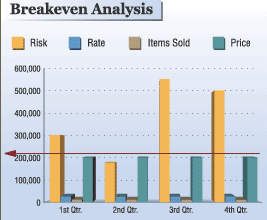Web Tools Seen Risky For Contractors
 We finally face recovery from 10 years of dismal resultsresults that were brought on by low pricing and bad risk selection. We can look back and say that we “shoulda” made smarter underwriting decisions, we “coulda” priced the risk more intelligently, and we “woulda” had better results.
We finally face recovery from 10 years of dismal resultsresults that were brought on by low pricing and bad risk selection. We can look back and say that we “shoulda” made smarter underwriting decisions, we “coulda” priced the risk more intelligently, and we “woulda” had better results.
Such a review would reveal that we charged too little for too much unmeasured risk.
Now, lets take these behaviors and apply them to the precarious small contractors class of business and write that business at lightening speed. Now, you have dismal results–faster.
Mission accomplished, right?
Is the Internet going to solve the profitability woes of business insurance writers?
No one will argue that you can do business cheaply on the Internet once you get beyond the start up costs. It is a more efficient way to give business customers more resources and it creates the ability to communicate with a very wide audience.
Insurance companies are developing online sales strategies for small contractors. Small contractors are not small because of their exposure–they are small because of their revenues.
I am not unreasonable. I think that there are ways to sell commercial insurance on the Internet profitably. I just dont think that there are enough contractors that will desire to shop for it online.
It is nothing personal, but contractors are not usually known for their insurance acumen. I think that a trained underwriter should review the risk a contractor creates. I think that because the risk can vary and change quickly and you need a human being to decide if the pricing is appropriate for those variances.
 The problem is that all loss sources cannot be contemplated and loss sources often change. History has taught us this with the advent of contractual risk transfer, lead, asbestos, pollutionand the list goes on. These losses were not contemplated when the contract was priced at its inception.
The problem is that all loss sources cannot be contemplated and loss sources often change. History has taught us this with the advent of contractual risk transfer, lead, asbestos, pollutionand the list goes on. These losses were not contemplated when the contract was priced at its inception.
Among some of the recent unconsidered loss sources are: mold for heating, ventilation and air conditioning (HVAC) contractors, excavating to lay low voltage wiring for electricians, the latest theft ring of contractors equipment, and exterior insulation finishing systems for wall contractors.
These things happen no matter what distribution system you use, but you need to have a system that is easy to re-enter and make changes to. All risks are not created equal.
What are the long-term cost savings of online sales strategies to the insurance companies?
The creators of one online insurance marketplace have offered the familiar list presented in the accompanying chart.
Although this online mall of insurance carriers does not sell small contractors insurance (yet), the same basic assumptions are being made by the brick and mortar companies entering into this business strategy.
The adjoining column of the chart offers reasons for this writers skepticism about the possible benefits.
In order to pre-screen and qualify customers for a Web-based sales model, homogeneous criteria are developed and warehoused as desirable risk qualities. When an application is completed, the information is considered acceptable or not and the price is determined.
What happens to warehouse rules when a change in the environment occurs–when a new loss source emerges that has no loss code because it wasnt anticipated, like mold or negligent hiring?
 Data warehousing, combined with underwriting intelligence, can bring very profitable results, but you must design a system that is nimble enough to accept changes quickly.
Data warehousing, combined with underwriting intelligence, can bring very profitable results, but you must design a system that is nimble enough to accept changes quickly.
In order to determine if a profit can be realized, a break-even analysis can be used. The theory is that in order to reach a point where your expenses are recovered by sales and you “break even”, you must write a set number of policies at a specific dollar amount.
In the example shown on the accompanying graph, the cost to develop and deliver a new product is $200,000. Through research, you know that no one will pay more than $2,000 a unit. So you must sell 1,000 of them to break even and recover your $200,000. (Note: you cannot get more because everyone is selling it for less.)
In the business of small contractors, the product offering is the same for everyone, but the risk youre writing is not.
Risk is determined by probable dollars lost based on actual exposures. But because of fierce competition, no one will buy this product for more regardless of the probable loss being greater than the premium collected.
A warehouse pricing model assumes all risks are constant and have filed rates per state by classification. This model is unrealistic because the filed rate is based on norms, not risks!
By its very nature, risk is not constant; its is uncertain and variable.
Let me give you an example: electricians. Lets suppose that your rate for electricians class #12345 is $.55 for $500,000 limits. The online application asks: “Do you do any outside work? Any high voltage?”
Applicants who install low voltage wiring will answer, “No.”
It is incidental that they excavate to get the wiring laid. However, the losses that are occurring because there are inexperienced contractors digging up gas lines are growing at an alarming rate.
Is this exposure contemplated in your filed rate? No, because not all electricians do this work and no one would buy this product if you charged more. This is a non-contemplated variable.
In the personal lines arena, companies thought that the Internet would be a major source of new sales, but in reality online sales accounted for only 1 percent of total sales for one company that recently pulled the plug on its Internet sales initiative.
Wausau Insurance stopped selling policies to small business on the Internet after an 18-month effort and after incurring the costs of setting up its online initiative. eWausau.com found out that small-business owners have been slow to embrace the Internet for their insurance needs. This effort returned less than 1 percent of the companys total sales, according to a company statement posted on the Web site. This strategy change will eliminate 120 jobs, the company said.
Wouldnt the initial start up costs have been better spent hiring 40-50 underwriters and getting better training for the current underwriters?
Another area of disappointment is lead generation. Most people come to the Internet to avoid speaking to a live person, so it is unlikely that they will follow up with a call to the agents. But the sale of an insurance policy involves complicated contractual language and usually requires professional interaction.
Customers are looking for the best deal. It takes effort on the part of the shopper to understand the system and the contractual mumbo jumbo, and there is always concern over transmission of what may be confidential information. The reward must be worth the effort. That reward is usually lower premiums.
“Save up to 15 percent on professional liability coverage,” is the promise displayed on the home page of one Web-based company offering policy quotes to small businesses from a group of property-casualty insurance company partners.
You have to read so much contractual language before you can get to the business of getting a quoteso why bother?
(When was the last time you read the entire content of a Mircrosoft 2000 users agreement on your computer? You ignore it and answer, yes, I agree!)
As a consumer I may go to the small business coverage Web site because its fast (not), its convenient (no), and its there when I want it (OK, that one works).
One out of three: abort mission and call agent!
Circle back with me now. Can we afford to sell commercial insurance to small contractors over the Internet where the users are few, the price is determined without consideration of the risk variables and to a group where profitability has always been a struggle?
Barbara Reardon is the owner of Educating Underwriters Consulting, Inc., a Batavia, Ill.-based education and underwriting consulting firm dedicated to providing personalized online training and mentorships for commercial underwriters. The Web address is www.educatingunderwriters.com.
Reproduced from National Underwriter Property & Casualty/Risk & Benefits Management Edition, September 10, 2001. Copyright 2001 by The National Underwriter Company in the serial publication. All rights reserved.Copyright in this article as an independent work may be held by the author.
Want to continue reading?
Become a Free PropertyCasualty360 Digital Reader
Your access to unlimited PropertyCasualty360 content isn’t changing.
Once you are an ALM digital member, you’ll receive:
- Breaking insurance news and analysis, on-site and via our newsletters and custom alerts
- Weekly Insurance Speak podcast featuring exclusive interviews with industry leaders
- Educational webcasts, white papers, and ebooks from industry thought leaders
- Critical converage of the employee benefits and financial advisory markets on our other ALM sites, BenefitsPRO and ThinkAdvisor
Already have an account? Sign In Now
© 2025 ALM Global, LLC, All Rights Reserved. Request academic re-use from www.copyright.com. All other uses, submit a request to [email protected]. For more information visit Asset & Logo Licensing.








